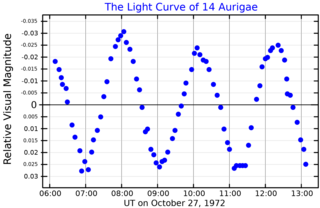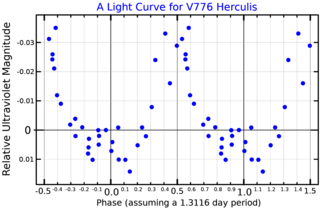Related Research Articles

Chi Serpentis is a solitary star in the Serpens Caput section of the equatorial constellation Serpens. Based upon an annual parallax shift of 14.84 mas as seen from Earth, it is located around 222 light years from the Sun. The star is bright enough to be faintly visible to the naked eye, having an apparent visual magnitude of +5.30.

Pi Virginis is a binary star in the zodiac constellation of Virgo. It is visible to the naked eye with an apparent visual magnitude of 4.64. The distance to this star, based upon parallax measurements, is roughly 380 light years.

2 Andromedae, abbreviated 2 And, is a binary star system in the northern constellation of Andromeda. 2 Andromedae is the Flamsteed designation. It is a faint star system but visible to the naked eye with a combined apparent visual magnitude of 5.09. Based upon an annual parallax shift of 7.7 mas, it is located 420 light years away. The binary nature of the star was discovered by American astronomer Sherburne Wesley Burnham at Lick Observatory in 1889. The pair orbit each other over a period of 74 years with a high eccentricity of 0.8.

56 Arietis is a single, variable star in the northern zodiac constellation of Aries. It has the variable star designation SX Arietis, while 56 Arietis is the Flamsteed designation. This object is visible to the naked eye as a faint, blue-white hued point of light with a baseline apparent visual magnitude of 5.79. The estimated distance to this star is approximately 415 light-years, based on parallax, and it is drifting further away with a radial velocity of +18 km/s.
16 Aurigae is a triple star system located 232 light years away from the Sun in the northern constellation of Auriga. It is visible to the naked eye as a faint, orange-hued star with an apparent visual magnitude of 4.547, and is located about 2/3 of the way from Capella toward Beta Tauri. It also lies in the midst of the Melotte 31 cluster, but is merely a line-of-sight interloper. The system has a relatively high proper motion, advancing across the celestial sphere at the rate of 0.166 arc seconds per annum, and is moving closer to the Earth with a heliocentric radial velocity of −28 km/s.

9 Aurigae is a star system in Auriga (constellation). It has an apparent magnitude of about 5, making it visible to the naked eye in many suburban skies. Parallax estimates made by the Hipparcos spacecraft put it at about 86 light-years from the solar system, although individual Gaia Data Release 3 parallaxes place all three components at 88 light years.

14 Aurigae is a quadruple star system located 269 light years away from the Sun in the zodiac constellation of Auriga. It has the variable star designation KW Aurigae, whereas 14 Aurigae is the Flamsteed designation. It is visible to the naked eye as a faint, white-hued star with a combined apparent visual magnitude of 5.01. The system is moving closer to the Sun with a heliocentric radial velocity of −9 km/s.
Omicron Aurigae, Latinized from ο Aurigae, is the Bayer designation for an astrometric binary star system in the northern constellation of Auriga. With an apparent visual magnitude of 5.47, it is faintly visible to the naked eye. Based upon an annual parallax shift of 7.89 ± 0.84 mas, it is approximately 413 light-years distant from Earth. The star is a member of the Ursa Major stream of co-moving stars.

36 Aurigae is a single variable star located about 910 light years away from the Sun in the constellation Auriga. It has the variable star designation V444 Aurigae, while 36 Aurigae is the Flamsteed designation. This object is visible to the naked eye as a dim, white-hued star with a baseline apparent visual magnitude of 5.71. It is moving further from the Earth with a heliocentric radial velocity of +16 km/s.

AR Aurigae, also known by its Flamsteed designation 17 Aurigae, is a binary star in the constellation Auriga. Based on parallax measurements made by the Hipparcos spacecraft, it is approximately 461 light-years from Earth.

15 Cancri is an α2 CVn-type variable star in the zodiac constellation of Cancer, located around 980 light years away. It has the variable star designation BM Cancri ; 15 Cancri is the Flamsteed designation. This system is visible to the naked eye as a faint, white-hued star with an apparent visual magnitude of about 5.6. It is moving away from the Earth with a heliocentric radial velocity of 25 km/s.
5 Tauri is a binary star in the zodiac constellation of Taurus, located approximately 530 light years from the Sun. It is visible to the naked eye as a faint orange-hued star with an apparent visual magnitude of +4.14. It is moving further from the Earth with a heliocentric radial velocity of +14 km/s.

V538 Aurigae is a single star in the northern constellation of Auriga. With an apparent visual magnitude of 6.23, this star requires good dark sky conditions to view with the naked eye. It is located at a distance of 40.0 light-years (12.3 pc) from Sun based on parallax. The star is drifting further away with a radial velocity of 0.9 km/s. It is a member of the Local Association, and is most likely a thin disk star.

45 Herculis is a solitary variable star in the northern constellation Hercules. It has the Bayer designation l Herculis and the variable star designation V776 Herculis. The Flamsteed designation for this star comes from the publication Historia Coelestis Britannica by John Flamsteed. It is the 45th star in Flamsteed list of stars in the constellation Hercules, and is visible to the naked eye with a baseline apparent visual magnitude of 5.22. Parallax measurements show this star to be about 400 light-years away from the Solar System. It is moving closer to the Earth with a heliocentric radial velocity of −16 km/s.
23 Comae Berenices is a binary star system in the northern constellation of Coma Berenices, situated a few degrees away from the North Galactic Pole. It is visible to the naked eye as a faint, white-hued point of light with an apparent visual magnitude of 4.80. The system is located around 310 light years away from the Sun, based on parallax. It is moving closer to the Earth with a heliocentric radial velocity of −16 km/s.

Tau9 Eridani is a binary star in the constellation Eridanus. It is visible to the naked eye with an apparent visual magnitude of 4.63. The distance to this system can be estimated using the parallax method, which yields a value of roughly 327 light years.

Phi Herculis is a binary star system in the northern constellation of Hercules. Based upon an annual parallax shift of 15.99 mas as seen from Earth, it is located around 204 light years from the Sun. With a combined apparent visual magnitude of 4.24, it is bright enough to be seen with the naked eye.
Upsilon Herculis is a solitary star in the constellation Hercules. It is visible to the naked eye with an apparent visual magnitude of 4.74. Based upon an annual parallax shift of 8.78 mas as seen from Earth, it is located around 371 light years from the Sun. At that distance, the visual magnitude is diminished by an extinction factor of 0.09 due to interstellar dust.
Lambda Lupi, Latinized from λ Lupi, is a triple star system in the southern constellation of Lupus. It is visible to the naked eye with a combined apparent visual magnitude of 4.04. Based upon an annual parallax shift of just 4.20 mas as seen from Earth, it is located roughly 800 light years from the Sun. The system has a peculiar velocity of 27.4±4.9 km/s relative to its neighbors, making it a candidate runaway star system. It is a member of the Upper Centaurus–Lupus sub-group in the Scorpius–Centaurus OB association.

41 Tauri is a single-lined spectroscopic binary system in the zodiacal constellation of Taurus; 41 Tauri is its Flamsteed designation. The star has a visual magnitude of 5.19, making it visible to the naked eye from brighter suburban skies. Parallax measurements put it at a distance of roughly 404 light years from the Sun.
References
- 1 2 3 4 5 6 Brown, A. G. A.; et al. (Gaia collaboration) (August 2018). "Gaia Data Release 2: Summary of the contents and survey properties". Astronomy & Astrophysics . 616. A1. arXiv: 1804.09365 . Bibcode: 2018A&A...616A...1G . doi: 10.1051/0004-6361/201833051 . Gaia DR2 record for this source at VizieR.
- 1 2 Høg, E.; et al. (2000). "The Tycho-2 catalogue of the 2.5 million brightest stars". Astronomy and Astrophysics. 355: L27–L30. Bibcode:2000A&A...355L..27H.
- 1 2 3 4 5 6 7 8 Zverko, J.; Žižňovský, J.; Mikulášek, Z.; Iliev, I. Kh. (2008). "53 Aurigae revisited: a B9Mn + F0m composite spectrum". Contributions of the Astronomical Observatory Skalnaté Pleso. 38 (2): 467–468. Bibcode:2008CoSka..38..467Z.
- 1 2 Mermilliod, J.-C. (1986). "Compilation of Eggen's UBV data, transformed to UBV (unpublished)". Catalogue of Eggen's UBV Data. Bibcode:1986EgUBV........0M.
- 1 2 Anderson, E.; Francis, Ch. (2012), "XHIP: An extended hipparcos compilation", Astronomy Letters, 38 (5): 331, arXiv: 1108.4971 , Bibcode:2012AstL...38..331A, doi:10.1134/S1063773712050015, S2CID 119257644.
- ↑ Murphy, Simon J.; Corbally, Christopher J.; Gray, Richard O.; Cheng, Kwang-Ping; Neff, James E.; Koen, Chris; Kuehn, Charles A.; Newsome, Ian; Riggs, Quinlin (2015). "An Evaluation of the Membership Probability of 212 λ Boo Stars. I. A Catalogue". Publications of the Astronomical Society of Australia. 32: e036. arXiv: 1508.03633 . Bibcode:2015PASA...32...36M. doi:10.1017/pasa.2015.34. S2CID 59405545.
- 1 2 "Sixth Catalog of Orbits of Visual Binary Stars". United States Naval Observatory. Archived from the original on 1 August 2017. Retrieved 28 May 2017.
- 1 2 3 4 5 Wraight, K. T.; Fossati, L.; Netopil, M.; Paunzen, E.; Rode-Paunzen, M.; Bewsher, D.; Norton, A. J.; White, Glenn J. (2012). "A photometric study of chemically peculiar stars with the STEREO satellites - I. Magnetic chemically peculiar stars★". Monthly Notices of the Royal Astronomical Society. 420 (1): 757–772. arXiv: 1110.6283 . Bibcode:2012MNRAS.420..757W. doi:10.1111/j.1365-2966.2011.20090.x. S2CID 14811051.